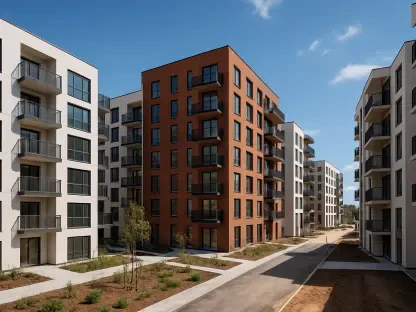In recent years, Canada’s housing sector has been grappling with challenges rooted in high demand, soaring costs, and limited supply. The nation’s burgeoning population and inflow of immigrants have only exacerbated these issues, creating a pressing need for innovative solutions. One such solution increasingly in the spotlight is prefabricated housing. Prefabrication, or prefab, refers to construction methods where building components are manufactured offsite and assembled on the construction site. This streamlined approach is gaining traction in Canada, primarily driven by the construction industry’s pursuit of cost-effectiveness and efficiency. With projections indicating that the modular construction market in Canada will grow significantly, there is an anticipation of increasing reliance on prefab solutions to meet housing demands. However, the transition is not without its hurdles, requiring not just innovation but collaboration and systemic support.
The Rise of Prefabricated Housing
The proliferation of prefabricated housing in Canada can be attributed to several pivotal factors, most notably the rising costs associated with traditional construction methodologies and the critical need for rapid housing solutions. Forecasts show that the modular construction market—as part of the broader prefabricated housing sector—could reach a valuation of $16.5 billion by the end of 2029. This anticipated growth reflects an annual increase rate of over 8%, underscoring the market’s expansion driven by technological advancements and shifting industry practices. The prefabricated home manufacturing sector continues to grow steadily, marked by sustained annual increases. These advancements stem from Canada’s urgent housing requirements coupled with government support, which serves as an encouraging backdrop for industry growth. Additionally, prefab construction has evolved vastly, incorporating innovative design and materials that enhance both efficiency and aesthetic value, making these homes a viable choice for modern living.
Technological innovations have been integral in reshaping the perception and utility of prefabricated homes. The application of advanced materials and assembly techniques aligns with the broader industry’s embrace of sustainability and reduced environmental impact. For instance, prefabricated homes boast the potential to lessen construction times significantly, thus contributing to lowering both financial costs and carbon emissions. With streamlined production processes and reduced waste, prefab housing presents a compelling case for eco-conscious building practices. Moreover, government policies aimed at fostering modular housing have also played a key role in energizing this sector. Various initiatives, ranging from financial incentives for builders to expedited permitting processes, exemplify efforts to legitimize and incentivize modular housing. Such endeavors aim to meet immediate housing needs while laying the groundwork for sustainable, scalable growth across the housing sector.
Government Initiatives and Private Investments
The Canadian government, both at provincial and federal levels, is increasingly recognizing the potential of prefabricated housing to alleviate housing shortages. This recognition has translated into substantial financial investments designed to boost the production and adoption of modular homes. Ontario, for example, has committed $50 million over a five-year period to enhance the capacity of its modular construction industry. This investment is meant to catalyze industrial growth, making housing more affordable and fostering innovation through technological adoption and production line upgrades. Meanwhile, at the national level, the Liberal government’s commitment of $26 billion—comprising debt and equity financing—demonstrates a significant financial undertaking aimed at supporting the prefab industry. These collective efforts signify a strategic alignment to leverage modular construction as a tool to resolve pressing housing issues.
Additionally, the private sector’s participation bolsters the prefabricated housing movement. Notable real estate stakeholders, such as Peter Gilgan, propose launching prefab factories to supply modular components for various housing projects. Such initiatives indicate a shift in strategy among traditional developers, who are now more inclined to integrate prefab methodologies within conventional frameworks. Toronto has also introduced streamlined permitting processes for factory-built homes, easing the bureaucratic pathway for developers interested in prefab ventures. These measures enact an alignment between government policies and private interest, arguably creating a fertile environment for the prefab industry to flourish. This collaborative approach aims to optimize housing production rates while reducing costs, ultimately paving the way for prefab homes to transition from a niche solution to a mainstream staple within the Canadian housing market.
Challenges and Strategic Considerations
Despite optimistic projections and supportive policies, the prefabricated housing sector faces notable challenges that could impede its potential. Among these challenges are the complexities of regulatory compliance across Canada’s varied provincial and municipal systems. Each region has distinct regulations which can impede the standardization of designs and processes in prefabricated construction. Achieving consistency and overcoming these bureaucratic obstacles are essential to fully realize the benefits of prefab housing across the nation. Another limitation inherent to prefabricated construction is its applicability, which traditionally favors repetitive and low-rise structure designs. Consequently, advancing the deployment of prefabricated solutions in high-density, multi-story residential markets remains a complex endeavor that demands innovative architectural strategies and increased collaboration with experienced builders.
Furthermore, the success of prefab housing relies heavily on the cohesiveness of its construction ecosystem. Builders, architects, and developers need to work in concert to design and execute modular projects effectively. Historical pitfalls, such as the ill-fated venture of Katerra, a well-funded modular builder that filed for bankruptcy in 2021, highlight the necessity for robust planning and implementation strategies within the prefab industry. Learning from international exemplars, nations such as Japan and Sweden provide valuable insights on best practices in prefab construction. These countries have successfully integrated prefabricated components into their housing markets, demonstrating potential pathways for Canada to emulate. If properly addressed, these strategic considerations could elevate prefab housing from a promising alternative to an indispensable element of Canada’s housing solution toolkit.
Path Forward for Modular Solutions
The growth of prefabricated housing in Canada is largely driven by the increasing expenses tied to traditional building methods and the urgent demand for swift housing solutions. The modular construction industry, a major part of the prefab housing sector, is projected to reach a $16.5 billion valuation by 2029, reflecting an annual growth rate of over 8%. This expansion is fueled by technological innovation and changing industry practices. The prefab home manufacturing field is experiencing consistent growth, thanks to Canada’s pressing housing needs and government backing, which support industry development. Modern prefab construction has integrated advanced design and materials, boosting both efficiency and visual appeal, making it an attractive option for contemporary living.
Advances in technology have transformed prefabricated homes by aligning with the industry’s sustainability goals, reducing environmental impact. These homes can drastically cut construction times, leading to lower costs and carbon emissions. Government policies offering financial incentives and quicker permitting processes support modular housing, allowing for immediate solutions and long-term sustainable growth.









